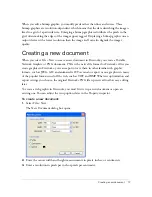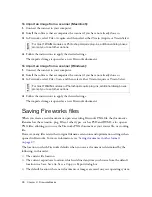
16
Chapter 2: Fireworks Basics
About vector graphics
Vector graphics render images using lines and curves, called vectors, that include color and
position information. For example, the image of a leaf may be defined by a series of points
that describe the outline of the leaf. The color of the leaf is determined by the color of its
outline (the stroke) and the color of the area enclosed by the outline (the fill)
When you edit a vector graphic, you modify the properties of the lines and curves that
describe its shape. Vector graphics are resolution-independent, which means you can move,
resize, reshape, or change the color of a vector graphic, as well as display it on output devices
of varying resolutions, without changing the quality of its appearance.
About bitmap graphics
Bitmap graphics are composed of dots, called pixels, arranged in a grid. Your computer screen
is a large grid of pixels. In a bitmap version of the leaf, the image is determined by the location
and color value of each pixel in the grid. Each dot is assigned a color. When viewed at the
correct resolution, the dots fit together like tiles in a mosaic to form the image.
Summary of Contents for FIREWORKS 8
Page 1: ...Using Fireworks...
Page 78: ...78 Chapter 3 Selecting and Transforming Objects...
Page 142: ...142 Chapter 5 Working with Vector Objects...
Page 166: ...166 Chapter 6 Using Text...
Page 192: ...192 Chapter 7 Applying Color Strokes and Fills...
Page 234: ...234 Chapter 9 Layers Masking and Blending...
Page 250: ...250 Chapter 10 Using Styles Symbols and URLs...
Page 324: ...324 Chapter 13 Creating Animation...
Page 372: ...372 Chapter 14 Optimizing and Exporting...
Page 444: ...444 Chapter 16 Automating Repetitive Tasks...
Page 454: ...454 Chapter 17 Preferences and Keyboard Shortcuts...
Page 472: ...472 Index...






























